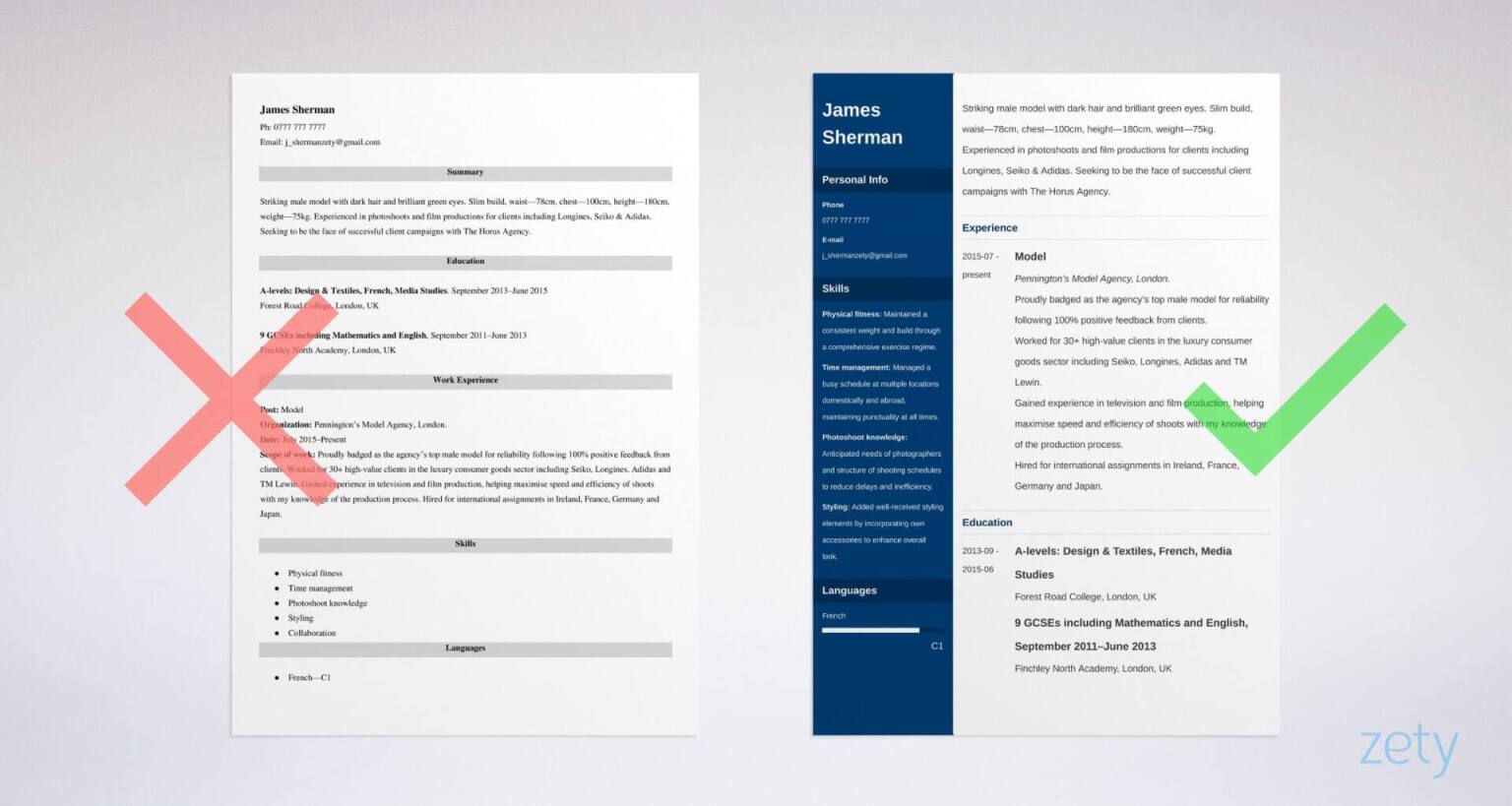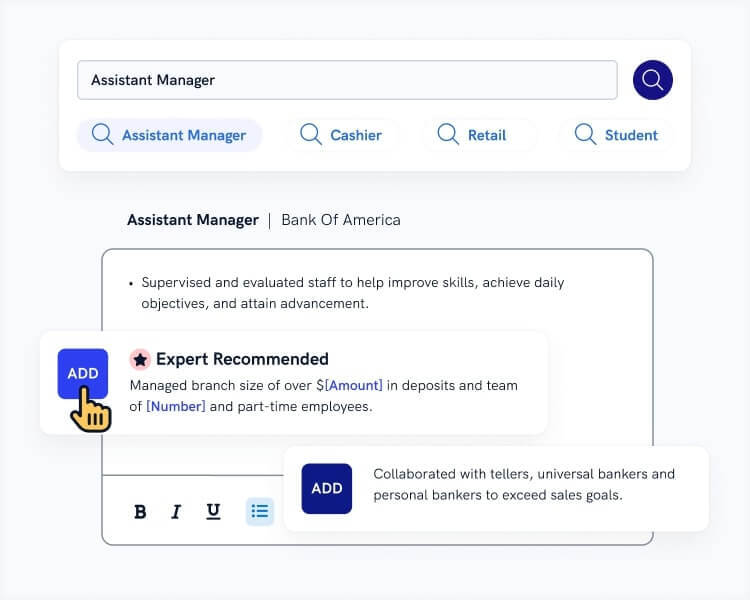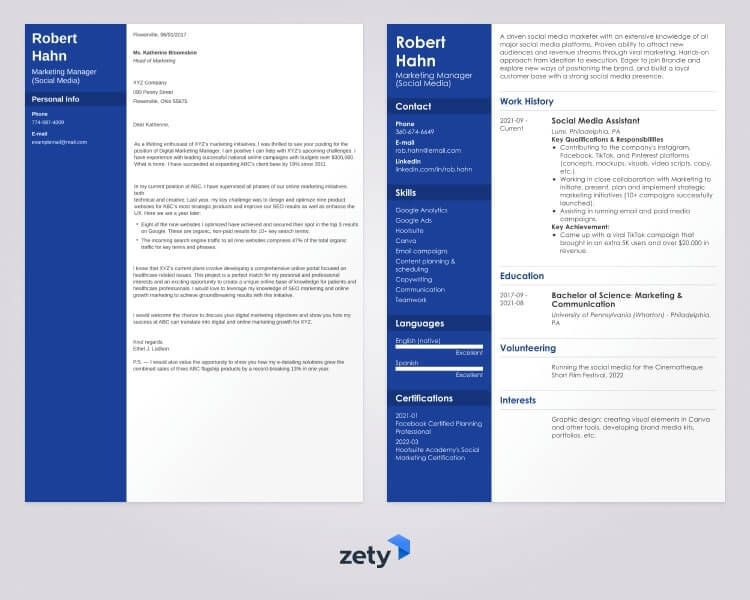Model CV Template: Tips for Writing a Modelling CV
Create your CV nowHow to write a modelling CV? It’s tricky, since your career is diverse, spanning haute couture to high street, and involves adding human context to fashion, goods, and services. However, there’s a way to do it right. Success requires a well-crafted CV.
This guide offers a professional model CV example and tips to make yours stand out. We’ll start with a CV sample created with our builder.
Want to save time and have your CV ready in 5 minutes? Try our CV builder. It’s fast and easy to use. Plus, you’ll get ready-made content to add with one click. See 20+ CV templates and create your CV here.
Model CV made with our builder—See more CV examples here.
And we’ve got CV writing guides for other careers too.
- CV for Work Experience Sample & Guide
- Pharmacist CV Example & Guide
- Bartender CV Example & Guide
- Internship CV Example & Guide
- Career Change CV Example & Guide
- Sales CV Example & Guide
- Barista CV Example & Guide
- Support Worker CV Example & Guide
- Recruitment Consultant CV Example & Guide
- Teaching Assistant (TA) CV Example & Guide
Model CV Template
James Sherman
Ph: 0777 777 7777
Email: j_shermanzety@gmail.com
Striking male model with dark hair and brilliant green eyes. Slim build, waist—78cm, chest—100cm, height—180cm, weight—75kg. Experienced in photoshoots and film productions for clients including Longines, Seiko & Adidas. Seeking to be the face of successful client campaigns with The Horus Agency.
Work Experience
Model
Pennington’s Model Agency, London.
July 2015–Present
- Proudly badged as the agency’s top male model for reliability following 100% positive feedback from clients.
- Worked for 30+ high-value clients in the luxury consumer goods sector including Seiko, Longines, Adidas and TM Lewin.
- Gained experience in television and film production, helping maximise speed and efficiency of shoots with my knowledge of the production process.
- Hired for international assignments in Ireland, France, Germany and Japan.
Education
A-levels: Design & Textiles, French, Media Studies. September 2013–June 2015
Forest Road College, London, UK
9 GCSEs including Mathematics and English, September 2011–June 2013
Finchley North Academy, London, UK
Skills
- Physical fitness: Maintained a consistent weight and build through a comprehensive exercise regime.
- Time management: Managed a busy schedule at multiple locations domestically and abroad, maintaining punctuality at all times.
- Photoshoot knowledge: Anticipated needs of photographers and structure of shooting schedules to reduce delays and inefficiency.
- Styling: Added well-received styling elements by incorporating own accessories to enhance overall look.
- Collaboration: Communicated closely with clients closely prior to assignments to determine their needs and adapt accordingly.
Languages
- French—C1
Now, your step-by-step guide to writing a model CV.
1. Put a link to your portfolio in your model CV header
I can’t emphasise this enough. A good CV is important but as a model, you need a portfolio too. So make sure you include an easy to find link to your online portfolio in your CV header.
That’s the very first part of your CV, right at the top of the page that includes your name and contact details. Here’s how to make your portfolio link pop.
- Start with a standard CV header, putting your name first in a font 4–6 points bigger than your body text.
- Then put a link to your portfolio immediately following your name. Make sure it’s a clickable hyperlink and bold it for good measure. You could even try having your name and the link in contrasting fonts, it’s called font pairing and it can add a really stylish touch to your CV when done properly.
- Follow up with standard CV personal details, your email address, phone number and LinkedIn profile link.
Read more: How to Include Personal Details on Your CV
2. Choose the best format for your model CV
A model helps to promote, display and advertise commercial products with their personal appearance. They also pose and act as subjects for artists and photographers. So the purpose of your modelling CV is to show you know how to market yourself effectively and deliver what the client wants.
And writing a CV is surprisingly similar to modelling, appearance is everything. Here’s how to make sure you’ve got the look and stay on-trend in your model CV template.
- Use the best CV format. It’s called chronological and it’s the traditional standard for CVs with a focus on your work experience.
- Create a CV layout as perfectly presented as you are. Style it up with one-inch margins on all sides of the page, double-spacing between CV sections and using left-alignment only. It’s not all about sleek good looks though. This creates white space, an important part of design composition that highlights important info and makes your CV easy to read.
- Select an elegant CV font. Try Garamond, Helvetica or Cambria. Something more en vogue than plain old Arial, but still professional.
- And to keep your layout looking fresh, save it in PDF format.
Pro Tip. You’ll often see advice not to include a photo of yourself on your CV. That’s true for most professions in the UK, but for a modelling CV a good quality headshot is an essential addition. Incorporate it into your CV header.
Read more: How to Layout a Professional CV
3. Write a model CV personal statement
This is the first section of your CV, a 3–4 line paragraph that’s also known as a personal profile or CV summary. It serves as the introduction to your CV, introducing you as a candidate. And it has to catch the attention of the hiring manager and convince them that you’re one for the yes pile. Here’s how to write it.
Essentially, you’ll be answering these questions.
- Who are you?
- What can you offer to the employer?
- What are your career goals?
The way you answer these questions is the key to writing a good CV summary. It’ll change depending upon how experienced you are. If you’ve got plenty of modelling experience under your belt then do this.
- Write down all of the experience and skills you have that make you a great model.
- Then have a look at the job advert and see what sort of look, skills and experience that it lists as requirements.
- Choose three to four points from your own list that match and write a personal statement that’s tailored to the modelling role you’re applying for.
And if you’re a new talent just getting started in modelling use this strategy.
- List any skills and experience you have that could be transferable to modelling. Think of what you’ve learned from previous jobs, and your education.
- Then create your CV summary by combining three to four relevant points from your list with passion and energy for the role and the employer to show you’ll be a great choice for the role.
And it’s always best to leave writing your personal profile until last. You’ll find it much easier to summarise when the rest of your CV is already finished and laid out in front of you.
Pro Tip: A modelling CV personal statement should always contain a brief description of your physical attributes too.
Read more: How to Write a CV Summary [Examples for 10+ Professions]
4. Pose a perfect model CV work experience section
Looks are important as a model, but real hands-on experience is still essential to doing your job effectively. Hiring managers want candidates who are familiar with the ins and outs of working with clients and managing the challenges of modelling gigs. Here’s how to show you’ve got the X factor.
- List your work history in reverse chronological order. Your most recent work experience goes first and you work backwards from there.
- For each entry, list the name of your employer, your dates of employment and your job title. Then write up to six bullet points for each entry describing the job.
- Make your bullet points pop by starting them with CV action words, like performed, facilitated or represented.
- And give them even more impact by structuring them with achievement statements. That way you’re not just saying what you did, you’re proving how well you did it.
The key to writing a successful work experience section is to target it to the job requirements. Compare it with the job advert and make sure you’ve matched the requirements as closely as possible.
Read more: How to Write Your CV Work Experience Section
5. Include an education section on your modelling CV
Successful modelling isn’t dependent on your educational attainments. But an education section is part of your model CV that agencies expect to see. Here’s what to do to make sure you’ve written it correctly.
- For school-leavers, write the location and name of the school and the dates you attended. For your-A-levels, least each individual subject you completed. But GCSEs are structured differently. Just mention the number of subjects you completed and only mention Maths and English specifically. It’s good practice, because many professions make passes in these subjects a minimum requirement.
- Then for university graduates and students, write the full formal name of the university, the years you studied there and the name of your degree. Include your expected graduation date if you’re still studying.
- And if you’ve just left school or uni within the last year and don’t have much experience then change your CV structure and put your education before your work history section.
6. Show your modelling CV skills
Your model CV needs to include a list combining soft skills and hard skills that prove you’ve got the abilities to do the job effectively. However, space is at a premium because the best CV length is just 1–2 pages. So how do you create a shortlist of skills that are still convincing enough to land you the job?
- Start with the job advert and write down all the skills that it mentions.
- Then make a list of your own skills. Remembering to make it a mix of soft skills and hard skills. And yes, you do have hard skills, such as knowledge of film and photo production processes.
- Then check what matches between the two lists and choose 5–10 points to include on your modelling CV.
- When you write each skill, include a brief sentence explaining how you demonstrate it. E.g. Physical fitness: Maintained a consistent weight and build through a comprehensive exercise regime.
Here are some skills that would make a great addition to your model CV.
Modelling skills for your CV
- Physical fitness
- Interpersonal skills
- Communication
- Collaboration
- Film production knowledge
- Photoshoot production knowledge
- Runway poise and confidence
- Time management
- Styling
- Organisational skills
When making a CV in our builder, drag & drop bullet points, skills, and auto-fill the boring stuff. Spell check? Check. Start building your CV here.
When you’re done, Zety’s CV builder will score your CV and tell you exactly how to make it better.
Read More: Best List of CV Skills [Job-Winning Examples]
7. Include extra sections to your model CV
The best models have a certain indefinable quality that makes them stand out from their peers. The best CV examples stand out too, but luckily the thing that does it is easy to define. Additional sections.
You could just stop with your skills section, but then your CV is going to look just like everyone else’s. And that won’t cut it when it comes to getting the best modelling jobs. You need to add some extra sections to elevate your CV from the ordinary. Here are a few ideas.
- Languages. Modelling is a career that can take you all over the world, so foreign languages will stand you in good stead. If you can speak another language then include a languages section on your CV.
- Other ideas include volunteering, awards or hobbies and interests. Anything that’s relevant and gives a positive impression of you as a candidate is worth considering.
Read more: Hobbies and Interests on a CV: Best List of Examples
8. Add a cover letter to your model CV
They’re often overlooked these days, but cover letters are still an important weapon in your fight for a new job. More than half of employers still consider them to be essential, so don’t cripple your chances of success by forgetting one.
Here’s how to write a cover letter for modelling jobs.
- Make sure it looks as good as your CV by choosing the best cover letter format and writing your cover letter address correctly.
- Put a ‘hook’ in your cover letter opening. Include an impressive accomplishment from your modelling career that’ll make the hiring manager want to keep reading and find out more.
- Fill the middle of your cover letter with more compelling professional accomplishments combined with positive energy and enthusiasm for the job.
- Include a call to action in your cover letter ending. Ask the hiring manager to contact you so you can discuss how you can excel at the job.
- And make sure you’ve chosen the perfect fit. Good models come in all shapes and sizes but the best cover letter length is no more than one page.
Plus, a great cover letter that matches your CV will give you an advantage over other candidates. You can write it in our cover letter builder here. Here's what it may look like:
See more cover letter templates and start writing.
And my last tip for you, follow up every job application. If you haven’t had a reply in within a week of applying make contact with the employer and check up on the status of your application. Many employers expect it of you and it can give one final boost to your chances of success.
About Zety’s Editorial Process
Our editorial team has thoroughly reviewed this article to ensure it follows Zety’s editorial guidelines. Our dedication lies in sharing our expertise and providing you with actionable career advice that offers you real value. Every year, the quality of our content attracts 40 million readers to our site. But that’s not all – we conduct original research to gain a detailed understanding of the labour market. We take pride in being cited by top universities and leading media outlets in the UK and worldwide.






![Should You Put Your Photo on Your CV? [Expert Advice]](https://cdn-images.zety.com/pages/cv_photo_zety_uk_1.jpg?fit=crop&h=250&dpr=2)